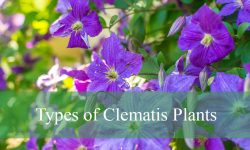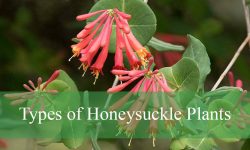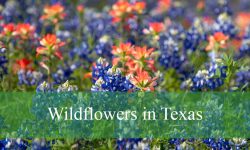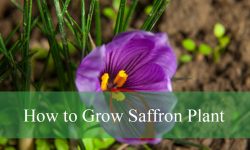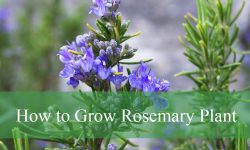Anywhere in the United States, an abundance of wildflowers in exquisite orange hues produces breathtaking scenery. It is impossible to list every species, variety, and subspecies because there are so many of them. Every species has distinct qualities and beauty of its own. The top 30 stunning orange wildflowers in the US will be discussed in this post.
Different types of Orange Wildflowers in the US
1. Tiger Lily
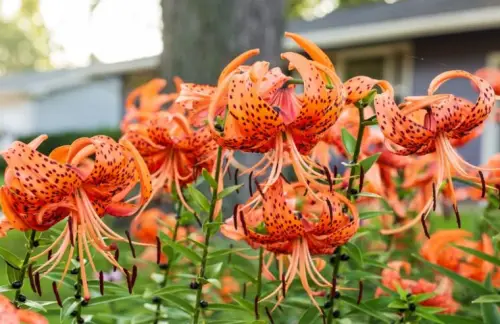
Tiger Lily (Lilium lancifolium), or Catesby’s Lily, thrives in USDA Hardiness Zones 7b-10a. This perennial grows 24-36 inches tall, boasting red-orange petals with a yellow spotted center. Though attracting pollinators, it requires careful maintenance due to sensitivity to salt, drought, and light deficiency. Its dormant bulbs can remain inactive for 5 years, flourishing after forest fires eliminate competitors.
2. Orange Milkwort
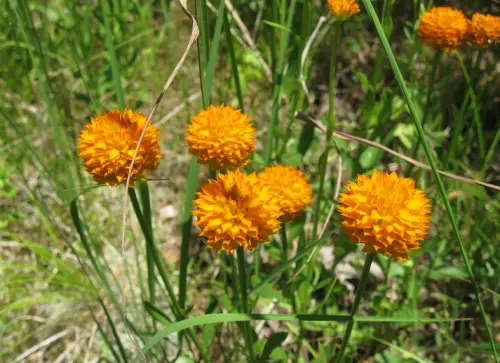
Orange Milkwort (Polygala lutea), also known as Candy Weed, thrives in USDA Hardiness Zones 6-9. Standing 8-20 inches tall, it bears dense clusters of vibrant orange flowers, later turning yellow. Spot this wildflower in US wetlands, forests, and bogs, earning the whimsical title “Bog Cheetos.”
3. Orange-fringed Orchid
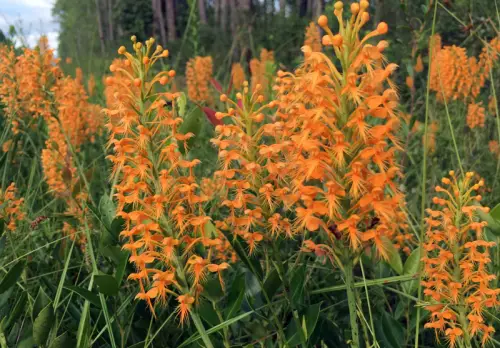
The Orange-fringed Orchid (Platanthera ciliaris), also known as Yellow-fringed Orchid, captivates in USDA Zones 5-9. Standing 24-35 inches tall, its vibrant yellow-orange flowers lure butterflies, despite its endangered status in several states due to habitat loss. To support its growth, consider planting seeds obtainable from local nurseries, as this robust, showy perennial is easily cultivated.
4. Berlandier Flax
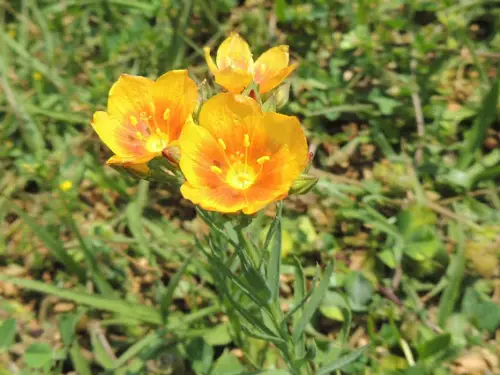
Berlandier Flax (Linum berlandieri) or Stiff-stem Flax thrives in USDA Zones 6-10, reaching 2-16 inches in height. Its fleeting yellow-orange blooms, lasting only a day or two, contrast the long, tapered, grayish-green leaves. Native to the US, it adapts to various habitats, showcasing its short-lived yet stunning blossoms.
5. Texas Lantana
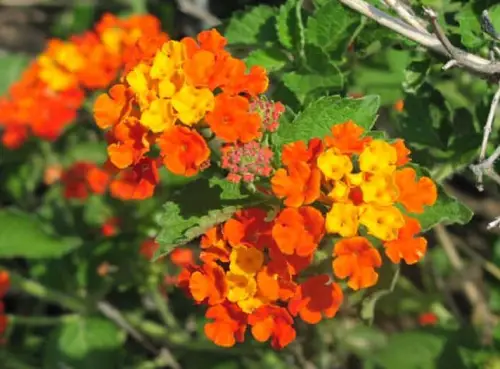
Texas Lantana (Lantana urticoides), or Calico Bush, thrives in USDA Zones 8-10, standing 36-72 inches tall. Valued for its role in supporting wildlife, it serves as a vital nectar and food source for various insects, including the Lantana Scrub Hairstreak caterpillar. While its green and purple berries are toxic to humans and livestock, they offer sustenance for hummingbirds, enhancing their presence during the plant’s vibrant blooming season.
6. Texas Paintbrush
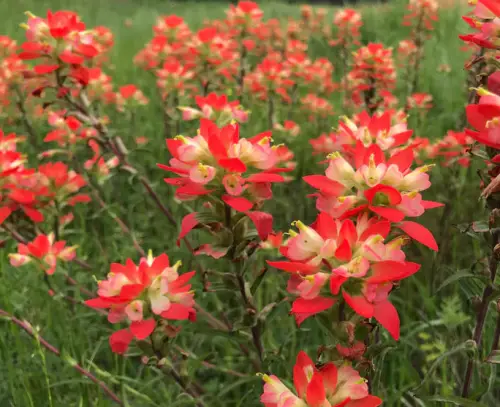
Texas Paintbrush (Castilleja indivisa), or Texas Indian Paintbrush, thrives in USDA Zones 6-11, growing 12-18 inches tall. Its striking red spikes are actually bracts, with small white flowers nestled within. Ideal for gardens, it attracts hummingbirds, butterflies, and other nectar-seeking pollinators with its vibrant display.
7. Standing Cypress
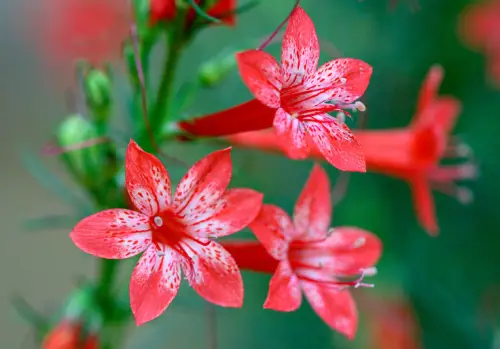
Standing Cypress (Ipomopsis rubra) or Texas Plume thrives in USDA Zones 6-9, reaching 24-72 inches in height. With its upturned tubular flowers flaunting stunning red hues and inner orange and yellow spots, it’s a hardy and low-maintenance addition to American gardens and fields. Sow its seeds to invite grateful hummingbirds, as this resilient plant easily resists pests and diseases.
8. Few-flowered Milkweed
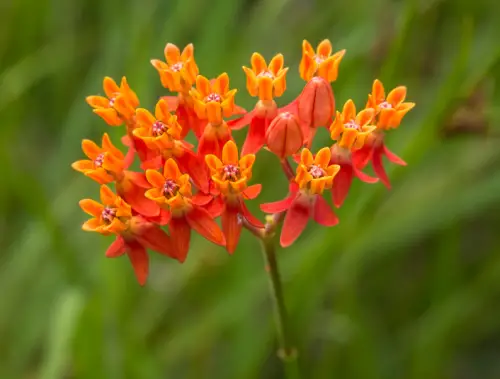
Few-flowered Milkweed (Asclepias lanceolata) thrives in USDA Zones 5-11a, standing 36-72 inches tall. Despite producing fewer flowers, its extended blooming period adorns the landscape with vivid red-orange blooms. Note its moderate toxicity when handling, deterring grazing animals. Large quantities ingested by humans may induce vomiting, spasms, and muscle weakness, emphasizing the need for caution around this orange wildflower.
9. Tropical Milkweed
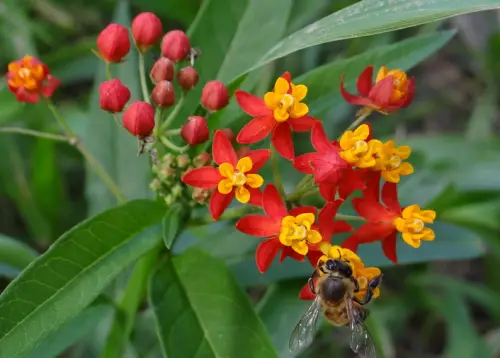
Tropical Milkweed (Asclepias curassavica), nicknamed Scarlet Milkweed, exhibits backward-bending orangish-red petals and a yellow star-shaped crown. Despite its non-native status, it invades many US regions, posing a threat to Monarch Butterflies. The plant hosts a parasite, Ophryocystis elektroscirrha (OE), potentially harming Monarch wings. To mitigate OE spread, cut back Tropical Milkweed at summer’s end and dispose of cuttings. Opt for native milkweed species to support local ecosystems and pollinators.
10. Firebush
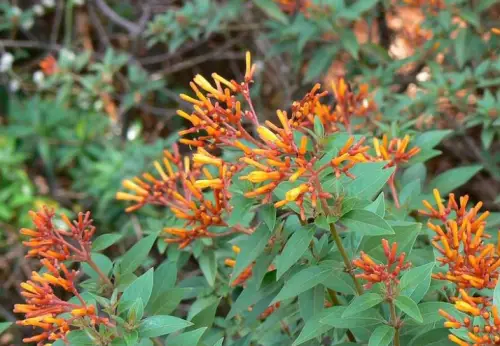
Firebush (Hamelia patens), also known as Hummingbird Bush, thrives in USDA Zones 9-11, reaching 36-180 inches in height. Sporting small, tubular, bright red-orange flowers, it flourishes easily in warm climates, blooming and fruiting year-round. Popular for its abundant nectar, it entices hummingbirds and songbirds, with edible berries for humans too. Its Mayan name, translating to “Guardian of the Forest,” aptly characterizes this resilient, sizable plant in the US.
11. Flame Azalea
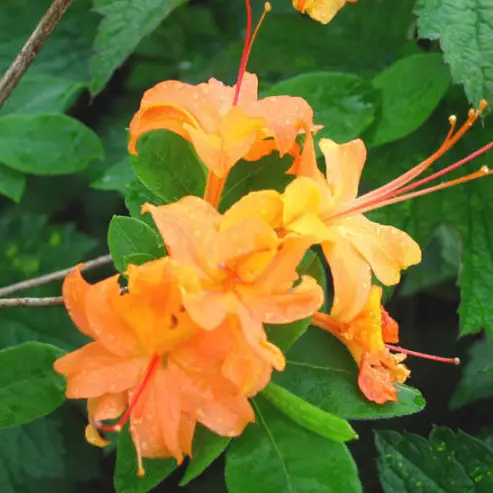
Flame Azalea (Rhododendron calendulaceum), also called Orange Azalea, enchants in USDA Zones 6b-9, towering 72-120 inches tall. Home gardens boast various cultivars, showcasing its clusters of fragrant, showy flowers in yellow, orange, and red hues. Native to the US, this orange wildflower effortlessly lures hummingbirds, butterflies, and pollinators. Easy to nurture from seed and transplant, it remains a favorite among rhododendron enthusiasts.
12. Orange Agoseris
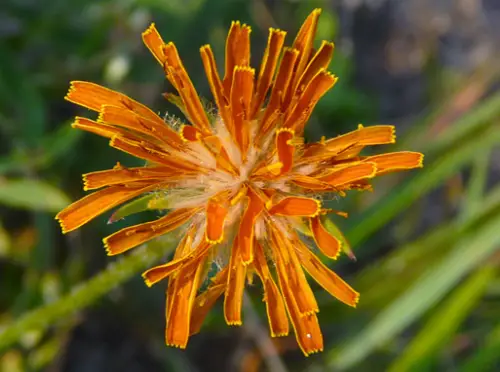
Orange Agoseris (Agoseris aurantiaca), or Orange-flowered False-dandelion, a member of the Sunflower family, sports coppery-orange flower heads usable for making Dandelion beer or wine. Edible leaves offer additional culinary options. After seeding, its flower head transforms into a white, airy sphere, dispersing seeds through the wind, facilitating the growth of new plants. Its hardiness zone remains unknown.
13. Wholeleaf Paintbrush
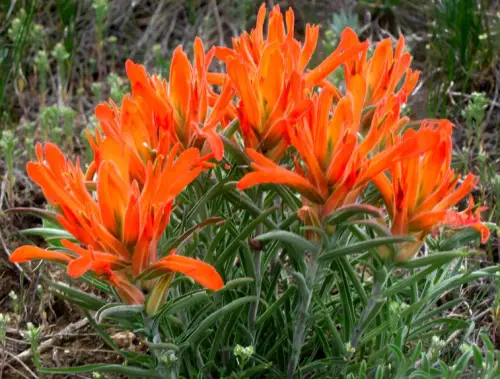
Wholeleaf Paintbrush (Castilleja integra), or Wholeleaf Indian Paintbrush, flourishes in USDA Zones 4-7, reaching 6-16 inches in height. Thriving in mountain oak and pine forests at 3,000-7,500 ft (914-2,286m) above sea level, it captivates with its vivid red-orange bracts rather than the small green protruding flowers. Identifiable by its hairy stems and leaves, this orange wildflower in the US showcases a unique, distinct appearance.
14. Orange Hawkweed
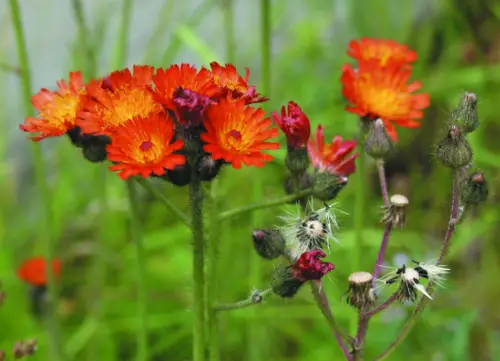
Orange Hawkweed (Hieracium aurantiacum), or Devil’s Paintbrush, thrives in USDA Zones 5-10, reaching 10-24 inches in height. With coppery, orange-red to yellow flowers boasting black tips, it entices numerous pollinators. Ancient Greeks believed hawkweeds’ milky sap enhanced hawks’ vision. Introduced to the US in the 1800s, most North American populations are genetic clones, suggesting a common origin. Be cautious; this orange wildflower proliferates rapidly.
15. Spotted Touch-Me-Not
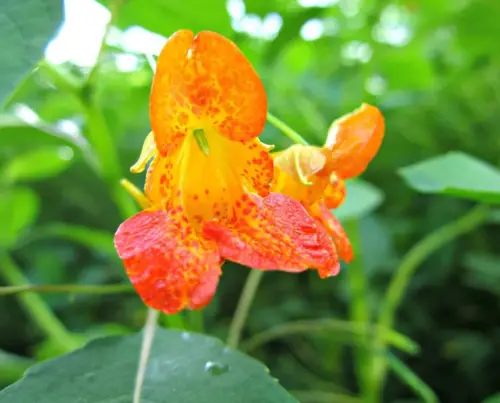
Spotted Touch-Me-Not (Impatiens capensis), or Orange Balsam, thrives in USDA Zones 2-11, rising 24-60 inches tall. Renowned for its yellowish-orange flowers with brown spots, its touch-sensitive seed pods burst upon contact. Comprising a significant portion of the Ruby-throated Hummingbird’s diet, its long tubular flowers allure these birds, making it an ideal addition for bird enthusiasts in the US. Additionally, seeds serve as nourishment for birds like the Ruffed Grouse and the Ring-necked Pheasant.
16. Butterfly Weed
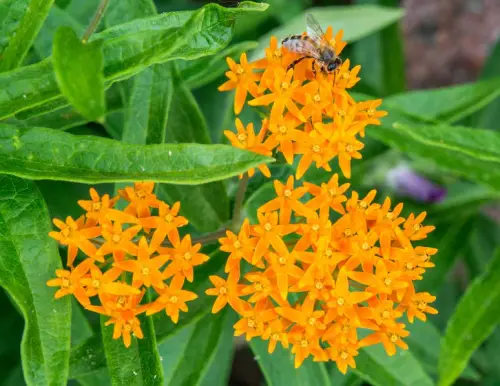
Butterfly Weed (Asclepias tuberosa), or Orange Milkweed, thrives in USDA Zones 3-9, standing 18-36 inches tall. Adorning many gardens, it flaunts a flat-topped, vibrant orange flower cluster, attracting butterflies and hummingbirds with its copious nectar. Native Americans historically chewed its root to alleviate respiratory issues and brewed tea for stomach ailments, reflecting its medicinal qualities linked to the Greek god of medicine, Asclepias. Caution is advised when handling its toxic root and sap.
17. Wood Lily
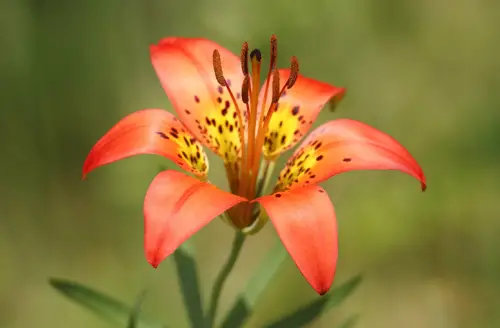
Wood Lily (Lilium philadelphicum), also known as Red Lily, thrives in USDA Zones 4-8, reaching 12-36 inches in height. Its upward-facing petals entice hummingbirds and butterflies, ensuring efficient cross-pollination. Admired for its red-orange flowers adorned with purplish freckles, each bloom remains open for 8-11 days, a unique trait among US orange wildflowers. Edible bulbs akin to turnips are a delicacy, yet due to excessive picking, the Wood Lily faces habitat depletion.
18. Michigan Lily
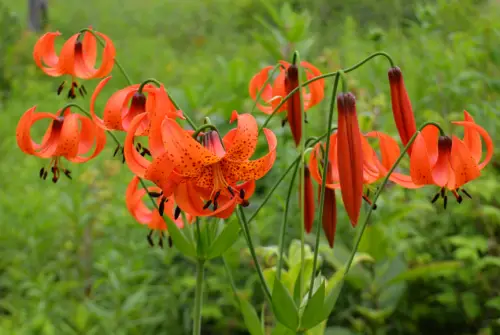
Michigan Lily (Lilium michiganense) flourishes in USDA Zones 2-7, growing 18-48 inches tall. Notable for its red-orange petals bearing brown and purple spots, it charms with its petals curving back toward the stem. Given its 4-5 year seed-to-bloom cycle, gardeners often opt for bulbs or mature plants. Its vibrant blooms attract Ruby-throated Hummingbirds and Monarch Butterflies, enhancing the appeal of your garden with this US native.
19. Crossvine
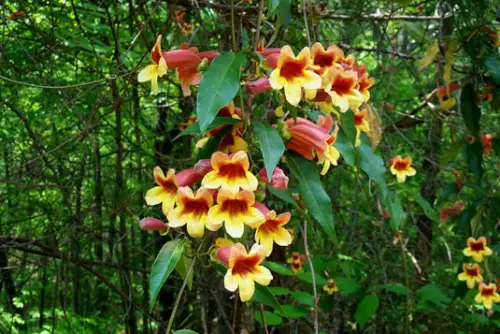
Crossvine (Bignonia capreolata), also known as Trumpet Flower, thrives in USDA Zones 5-9, climbing 36-50 feet tall. Unlike typical orange wildflowers, it creeps and flourishes in late winter and early spring, serving as a vital food source for overwintering birds. Boasting long tubular flowers in gold, orange, and burgundy, it resembles the hummingbird trumpet vine. Caution is advised, as this plant is highly flammable, requiring a safe distance of at least 30 feet (9 meters) from structures.
20. Blanket Flower
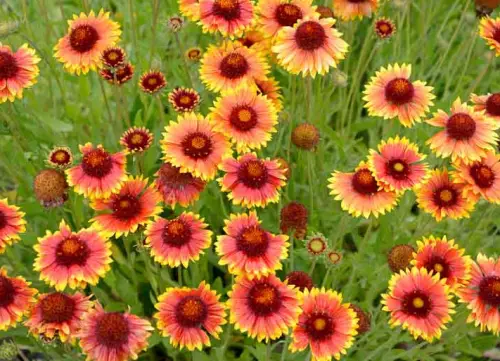
Blanket Flower (Gaillardia pulchella), or Indian Blanketflower, thrives in USDA Zones 2-11, growing 12-24 inches tall. Its vibrant display of red, orange, and yellow petals beckons bees and birds. Popular among beekeepers, it yields mild, buttery, amber-colored honey. Leave some seedheads post-flowering for Goldfinches to relish. Whether in gardens or the wild, this orange wildflower enriches landscapes with its striking beauty and ecological contributions.
21. Carolina Lily
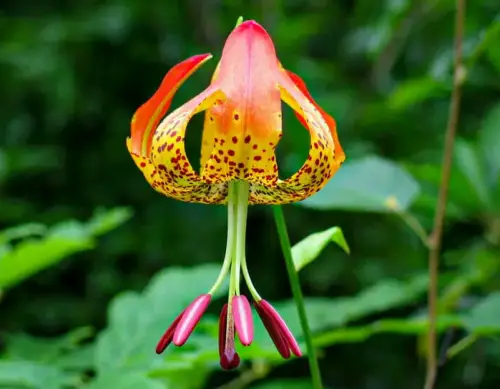
Carolina Lily (Lilium michauxii), or Michaux’s Lily, thrives in USDA Zones 6-9, reaching 24-48 inches in height. Recognizable by its unique, alluring fragrance, it remains the sole fragrant lily east of the Rocky Mountains. Its distinct orange petals feature red and yellow splashes curving toward the stem. Welcoming pollinators like hummingbirds and butterflies, it’s also a tempting meal for deer and rabbits, necessitating caution in areas with such wildlife.
22. California Poppy
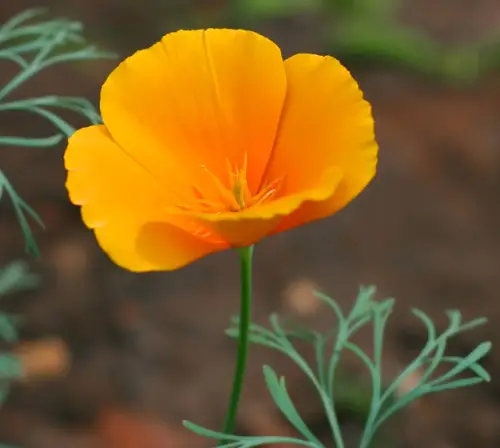
Native to the US, the California Poppy (Eschscholzia californica) is a popular ornamental plant with cup-shaped spring flowers in vibrant orange, occasionally in red, yellow, pink, and white. This perennial or annual grows up to 30 centimeters, boasting alternating blue-green leaves. Its exquisite four-petaled blooms open from February to September, closing at night and in cold weather, reopening each morning.
23. Scarlet Pimpernel
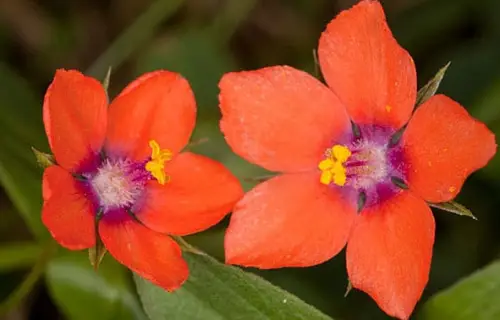
Known as the poor man’s weather glass, Scarlet Pimpernel (Lysimachia arvensis) boasts scarlet flowers and is widespread in Europe and North Africa. Despite its ornamental use, it’s considered a weed in the US, often indicating light soil. With low-creeping stems and opposite bright green leaves, its symmetrical orange, red, or blue flowers with hairy petal margins and stamens allure pollinators. It earned its name from its tendency to open in sunlight and close during cold or dark periods, often spotted along roadsides.
24. Orange Bush Monkeyflower
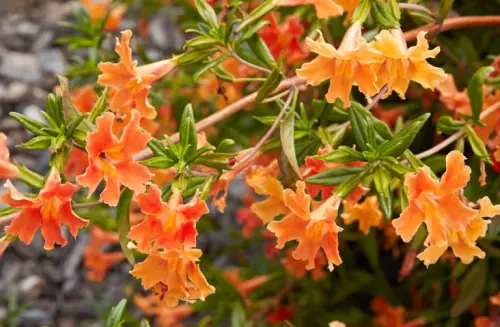
The Orange Bush Monkeyflower (Diplacus aurantiacus) is a shrub-like wildflower native to southwestern North America, spanning Oregon to California. Reaching 1.2 meters in height, it features green, adhesive leaves and upright flowering stems. Its tubular light orange flowers, also found in white or red, attract hummingbirds and bees. Thriving in diverse environments, from wet to rocky, dry, or sandy soils, it serves as a vital host plant for common buckeye butterfly larvae. Valued for its medicinal properties, Native Americans have long used it to treat burns, eye irritation, and sores, while its flowers are used for decorative purposes.
25. Western Wallflower
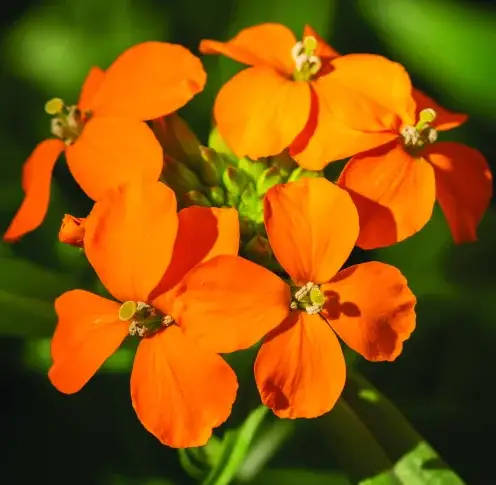
The Western Wallflower (Erysimum capitatum), or prairie rocket, graces North America, primarily in California. This mustard-like plant flaunts slender, upright stems and stunning, primarily orange, but also bright gold, yellow, red, purple, or white flowers. Thriving in foothills, coniferous forests, and plains, it’s cherished for its medicinal benefits, known to alleviate muscle aches. Its flowers and fruit are consumed for relief from stomach discomfort.
26. Apricot Mallow
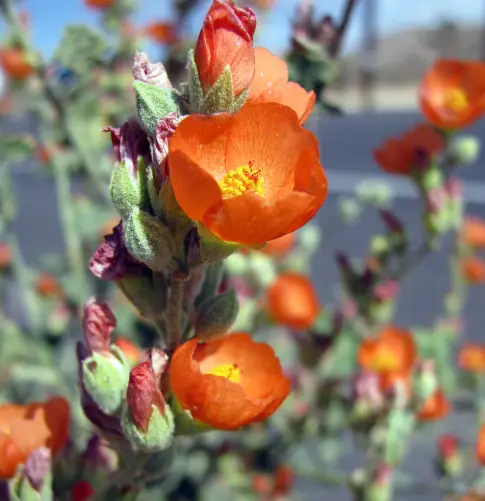
Apricot Mallow (Sphaeralcea ambigua) is a perennial shrub that grows well in alkaline soil in the desert chaparrals and bush scrub of Nevada, California, New Mexico, Utah, and Arizona. It is three feet tall and three feet wide, with fuzzy leaves with white hairs and beautiful bowl-shaped apricot-orange flowers in spring. It supports the painted lady, little checkered skipper, common checkered skipper, and West Coast woman. It is used by the Shoshoni tribe as a food source and medicinal herb.
27. Orange Day-Lily
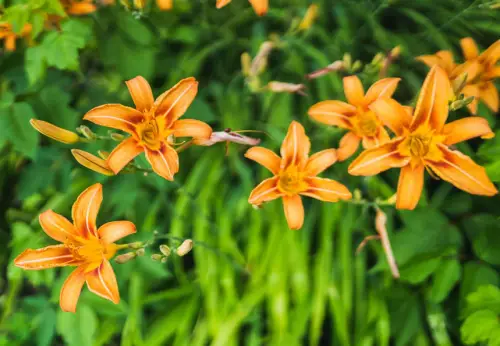
The Orange Day-Lily (Hemerocallis fulva), an Asian herbaceous perennial, is popular for its striking, orange-red flowers with a pale central line on the tepal. Towering up to 150 centimeters, it features long stems and large linear leaves up to five feet long. While each flower lasts only a day, they open successively from summer to late fall. Unfortunately, this once-cultivated plant has become an invasive species, spreading across woods, fields, ditches, and roadsides throughout the United States.
28. Garden Nasturtium
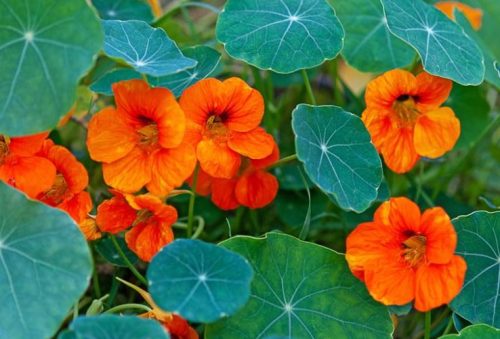
Native to Bolivia, the Garden Nasturtium (Tropaeolum majus) is also called Indian cress. It is an annual plant that has bright orange flowers and disc-shaped leaves. It has huge circular green leaves with elongated petioles and grows quickly, up to six feet. The sweet-smelling blooms have five petals, eight stamens, and a lengthy nectar spur that is frequently darker at the base. It is regarded as an invasive species in Hawaii, despite having been naturalized in a number of US states, including New York, California, New Hampshire, Pennsylvania, Virginia, Connecticut, and Massachusetts.
29. Columbia Lily
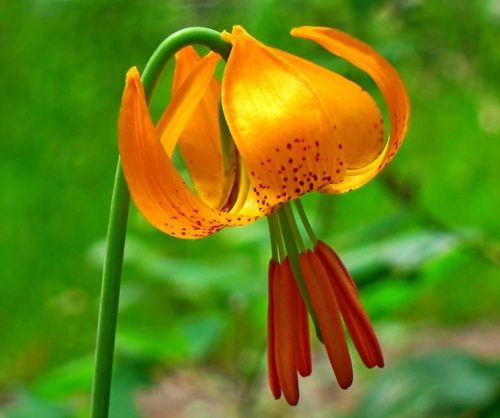
Native to western North America, the Columbia Lily (Lilium columbianum) grows well in meadows and lowland and montane forests. This perennial herb has many orange blossoms and can grow up to 1.2 meters in height. Its large tepals give off a nice scent, and its leaves spiral around the stem. This orange wildflower has been used for decades to add a subtle bitter or peppery flavor to soups and meat dishes.
30. Hoary Puccoon
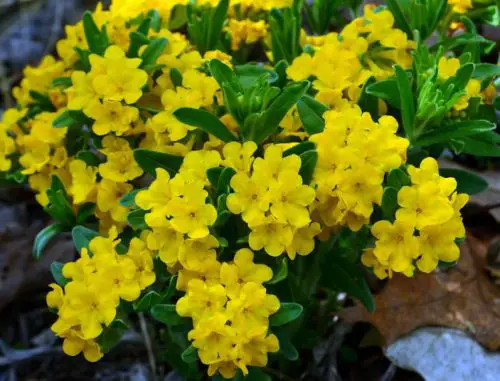
Hoary Puccoon, or Lithospermum canescens, is a North American perennial herb found in various habitats. Its golden-yellow to orange flowers bloom from April to May. Growing up to forty-one centimeters, it features gray-green, hairy leaves on multiple stems. This orange wildflower thrives in woodlands, road edges, and prairies. Native Americans historically used its root as a treatment for asthma and lung ailments.
People Who Read This Also Read:


